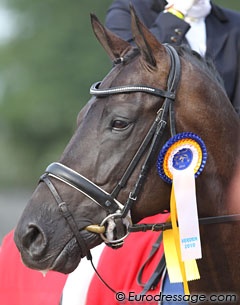
At the 2010 World Young Horse Championships in Verden, Dutch journalist Dirk Willem Rosie, editor in chief of the equestrian newspaper Het Sportpaard, approached me in the press centre with the question
if I wanted to be one of three contributors that would write an opinion piece on breeding for his paper. As Mr Rosie was kind enough to be a guest columnist for Eurodressage I gladly returned the favour.
But then Rosie mentioned the subject of the article: According to the WBFSH the best dressage horses are bred in The Netherlands. However, this ranking is based on international Grand Prix results, the breeding product of 15 years ago. The World Young Horse Championships probably give a more up to date view on the situation. If one looks at the horses at the 2010 World Championships, which country breeds the best dressage horses?
Contrary to some unfounded and rumoured belief, I don't take sides. The best horse has no colour, no brand, and certainly no nationality. So I decided to approach the matter as objectively as possible and wrote the following opinion piece:
The strong presence of the Danish and German delegation in Verden is striking this year. If one looks statistically at the number of finalists, than The Netherlands has only 50% of its horses (3 out of 6) in the 5-year old Finals, whereas Denmark has 75% (3 out of 4) and Germany even 85% (6 out of 7). Furthermore, Germany has an additional iron in the fire with its wild card, the Oldenburg bred Rebelle, ridden by Danish Maria Anita Andersen of Blue Hors Stud. In the 6-year old finals, the Danes dominate: the entire Danish team qualified for the finals, meaning 100% of its selected horses. The Germans again had six out seven in the finals, while The Netherlands had three out of six.
Despite the limited presence of the KWPN breed in the Finals, Emmelie Scholtens did win gold in the 5-year old division with the modern looking and energetic Astrix. The black pearl has 25% Trakehner in his blood, just like Totilas is 50% Trakehner. In general the Dutch bred horses are more athletic than the German ones, but the quality of gaits is not automatically better. The Germans have less electric horses but their rideability, balance and ability to carry the weight on the hindquarters are much better at this show. On the other side, the Dutch praised elastic Jazz offspring are modern in outlook, but are often too sensitive for many riders and have a limited ability to carry the weight behind, especially as young horses. In Verden there were only two KWPN bred horses which had Jazz in the first two generations. Furthermore it was very obvious that a large group of horses from various breeding areas paddled with the front legs or had crooked legs, including a few German licensed breeding stallions.
The Danes have an open breeding policy and combine the best lines of all studbooks. The dominance of the Oldenburg Don Schufro (by Donnerhall x Pik Bube I) is undeniable. Five 6-year old finalists carried the genes of the popular liver chestnut stallion owned by Blue Hors Stud. In the 5-year old finals the commercial Sandro Hit blood was most present, even though almost none of the Sandro Hit offspring makes it to Grand Prix.
Moreover this year the importance of the Hanoverian De Niro (by Donnerhall x Akzent II) is irrefutable. At Grand Prix level Dablino (by De Niro x Wanderbusch II), Delgado (by De Niro x Weltmeyer) and Desperados (by De Niro x Wolkenstein II) are the shooting stars of the year. At small tour level Fabienne Lutkemeier achieved a world record and Young Riders gold with D'Agostino (by De Niro x Shogun xx) while Sanneke Rothenberger was good for double Young Riders silver with former World Young Horse Champion Deveraux OLD (by De Niro x Weltmeyer). In Verden, the Hanoverian Du Soleil (by De Niro x Caprimond) was one of the most striking 6-year olds with clear Grand Prix potential.
It is hard to say which country breeds the best dressage horses, especially because the future of a dressage horse depends heavily on the trainer and rider and how fortunate they are on the way to Grand Prix (injuries, disease, sale, etc). The golden mean is an open policy: combining the best lines from all breeds, a strict vet check at stallion licensings and a test to check the character and rideability of young colts. One-sided trend breeding leads to stagnation.
-- Astrid Appels
info@eurodressage.com
Related Links
Eurodressage Coverage of the 2010 World Young Horse Championships
Visit our archive of Editorials